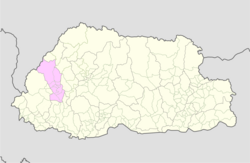Paro Valley
Paro district
སྤ་རོ་རྫོང་ཁག | |
|---|---|
District | |
 Map of Paro District in Bhutan | |
| Country | Bhutan |
| Headquarters | Paro |
| Area | |
• Total | 1,293 km (499 sq mi) |
| Population (2017) | |
• Total | 46,316 |
| • Density | 36/km (93/sq mi) |
| Time zone | UTC+6 (BTT) |
| HDI (2019) | 0.722 high · 2nd |
| Website | www |
Paro District (Dzongkha: སྤ་རོ་རྫོང་ཁག་; Wylie: Spa-ro rdzong-khag) is a district (dzongkhag), valley, river and town (population 20,000) in Bhutan. It is one of the most historic valleys in Bhutan. Both trade goods and invading Tibetans came over the pass at the head of the valley, giving Paro the closest cultural connection with Tibet of any Bhutanese district. The dominant language in Paro is Dzongkha, the national language.
The only international airport in Bhutan, Paro International Airport, is located in Paro district.
Geography



Paro District is bordered by Haa district to the west, Tibet to the north, Thimphu district to the east, and Chukha district to the south.
Administrative divisions
Paro Districts comprises ten village blocks (or gewogs):
Environment
Northern Paro District (the gewogs of Doteng and Tsento) contains part of Jigme Dorji National Park and the biological corridor connecting it to Torsa Strict Nature Reserve in neighboring Haa District.
A spiritual treasure lake known as Drakey Pangtsho said to be on the lap of Jowo Drake where Guru Rinpoche had hidden sacred treasures is in paro.
Cultural sites
Important cultural sites of Paro include:
- Taktshang, or Tiger's Nest, the most famous monastery and ancient highlights for the people of Bhutan. It was founded as a meditating cave by the famous saint Guru Padmasambhava in the early 8th century upon subjugating a demon and forcing him to take an oath to be the local protector of the region towards the very end.
- Kyichu Lhakhang, which along with Jambay Lhakhang in central Bhutan is the oldest temple in Bhutan, dating to the 7th century.
- Drukgyel Dzong, at the upper end of the valley, built to protect against invading Tibetans, but in ruins since a fire in the 1950s.
- Paro Town, the single market town in the dzonghag which is booming (by Bhutanese standards) due to an influx of tourist dollars.
- Rinpung Dzong, also known as Paro Dzong, the massive fortress/monastery which is also the administrative center of the dzonkhag. Scenes from the movie Little Buddha were filmed in and around this dzong.
- The National Museum of Bhutan, where visitors can learn about the culture of Bhutan.
- Dzongdrakha Goenpa is a sacred cliff of Guru Rinpoche above the two villages of Bonday and Gyepjag under Paro Dzongkhag blessed during his second visit to Bhutan in 822 A.D from Tibet.
- Chumophu Ney is a meditation place of Guru Rinpoche in Paro where the famous floating statue of Dorji Phagmo is defying gravity.
- Drakarpo is a sacred cliff that Guru Rinpoche broke and took out an evil spirit in the 8th century. This holy cliff, also known as the mini-Taktsang.
- Ragoey Ney is a sacred site blessed by Guru Rinpoche in the 8th century. The monastery houses a Guru Sungjoen Statue brought by a goat and a vulture from Punakha.
- Gom Drak is one of the Four Cliffs of Guru Rinpoche entrusted to Phajo Drugom Zhigpo in his prophetic vision.
- Jomolhari is a sacred mountain where a meditation cave of Guru Rinpoche and Khandro Yeshe Tsogyal meditated before flying back to Tibet.
- Namthong Karpo is a sacred cave where Guru Rinpoche meditated and subdued a sickle-faced demon.
- Bumdrak monastery is a sacred cliff of Guru Rinpoche where Goddess of the Fairies left 100,000 footprints.
- Hungrel Dzong is a fortress built on the sacred site of Guru Rinpoche by Drung Drung Gyelchog in the 15th century. It was a five-story structure, built of compact mud, and resembled Namgyal Khangzang.
Economy
Druk Air, the national airline of Bhutan, has its headquarters in Paro.
See also
References
- ^ "Sub-national HDI - Area Database - Global Data Lab". hdi.globaldatalab.org. Retrieved 2018-09-13.
- ^ "Chiwogs in Paro" (PDF). Election Commission, Government of Bhutan. 2011. Archived from the original (PDF) on 2 October 2011. Retrieved 28 July 2011.
- ^ "Parks of Bhutan". Bhutan Trust Fund for Environmental Conservation online. Bhutan Trust Fund. Archived from the original on 2 July 2011. Retrieved 26 March 2011.
- ^ "Drakey Pangtsho, a Treasure Lake on the Lap of Jowo Drake". bhutanpilgrimage.com. Retrieved 2025-01-27.
- ^ "Paro Taktsang, the Sacred Place of Guru Rinpoche's Enlightened Mind". bhutanpilgrimage.com. Retrieved 2025-01-27.
- ^ "Kyichu Lhakhang, the Sacred Jewel of Bhutan". bhutanpilgrimage.com. Retrieved 2025-01-25.
- ^ "Jambay Lhakhang, one of the Oldest Temples in Bhutan founded in 659 CE". bhutanpilgrimage.com. Retrieved 2025-01-25.
- ^ "Dzongdrakha, a Cliff from where a Relic of Chorten and Sangay Youelsum was Discovered". bhutanpilgrimage.com. Retrieved 2024-12-15.
- ^ "Chumphu Ney, where the Floating Statue of Dorji Phagmo defies gravity". bhutanpilgrimage.com. Retrieved 2024-12-15.
- ^ "Dra karpo, a Rock that Guru Rinpoche broke and took out an Evil Spirit". bhutanpilgrimage.com. Retrieved 2024-12-15.
- ^ "RaGoe Ney, the Destined Place of Guru Sungjoen brought by a Goat and a Vulture". bhutanpilgrimage.com. Retrieved 2024-12-15.
- ^ "Gom Dra, the Great Meditation Cliff of Guru Rinpoche Prophesied to Phajo Drugom Zhigpo". bhutanpilgrimage.com. Retrieved 2024-12-15.
- ^ "Jomolhari, where Guru Rinpoche Meditated before flying to Tibet". bhutanpilgrimage.com. Retrieved 2024-12-15.
- ^ "Namthong Karpo, where Mysterious Zuri Dzong Stands". bhutanpilgrimage.com. Retrieved 2024-12-15.
- ^ "Bumdrak Monastery, where Dakinis left 100,000 Footprints". bhutanpilgrimage.com. Retrieved 2024-12-15.
- ^ "Hungrel Dzong, a Fortress on the Holy site of Guru Rinpoche". bhutanpilgrimage.com. Retrieved 2024-12-15.
- ^ "Contact Us" . Druk Air. Retrieved on 8 October 2009. Archived September 1, 2009, at the Wayback Machine